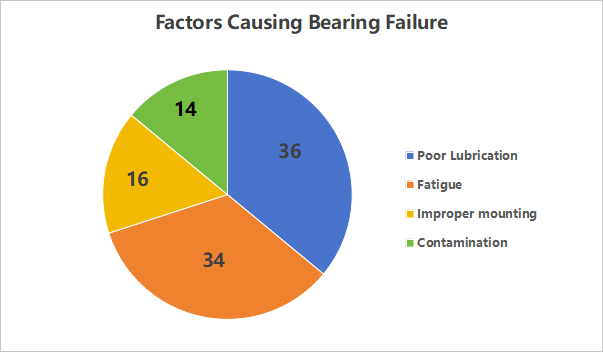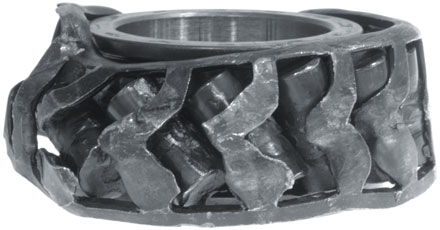Lubrication Guide for Cylindrical Roller Bearings
IntroductionWould you drive a car that didn’t have oil in it? They all work the same way. If you want your bearings to last longer and keep spinning smoothly, you need to make sure they are properly oiled.
So here’s the deal: poor lubrication is the main cause of bearing problems, accounting for 36% of all fails. That’s more than just tiredness, bad mounting, or even infection! Without the right lubrication, friction takes over, leading to heat, wear, and eventually breakdowns.
Reference: 5 most common causes of Premature Bearings Failure And How to Avoid Them on B2K
 Don’t worry, though. This guide will show you how to choose the right grease, use it correctly, and keep your cylindrical roller bearings in great shape. Whether you work in manufacturing, transportation, or any other field, these easy tips from TFL Bearings will help you save time and money and avoid problems.
Why Lubrication Matters for Cylindrical Roller BearingsProtect Against Wear and TearLubrication is like a protective shield for your bearings. It prevents the rolling parts from rubbing directly against each other, cutting down on friction and wear. If your bearings aren’t properly lubricated, they can break down much faster, and you’ll end up with a big repair bill.
Improve EfficiencyWhen your bearings are well-lubricated, they work more smoothly. This reduces the energy needed to run them, saving you power and cutting down on unnecessary heat buildup. A well-lubed bearing is a happy bearing!
Extend Service LifeThe right grease or oil doesn’t just help the parts move smoothly—it keeps dirt, moisture, and other harmful stuff out. Keeping the cylindrical roller bearing clean helps it run longer and reduces the chances of failure. The longer your bearings last, the less money and effort you’ll spend on repairs and replacements.
 Types of Lubricants for Bearings
Factors to Consider When Selecting Lubricants for Bearings
How to Lubricate Cylindrical Roller BearingsLubricating your cylindrical roller bearings doesn’t have to be a headache. Here’s a simple guide to get it done right:
1. Clean the AreaAsk yourself, “Is this area clean?” before you touch the grease. If dirt, dust, or other debris gets into the grease, it can ruin your work. Get rid of any dirt or dust on the bearing, tools, and even your hands with a clean rag or compressed air.
2. Pick the Right LubricantNot all lubricants are created equal. Choose one that matches your bearing’s needs—grease, oil, or maybe even a dry lubricant if the environment calls for it. Don’t rush here; it’s worth reading the manufacturer’s guidelines.
3. Apply the Right AmountHere’s the trick: don’t overdo it. Think of it like putting butter on toast—too much makes a mess, and too little doesn’t do the job. Use about one-third of the bearing’s free volume. A grease gun helps you apply just the right amount.
4. Spread It EvenlyTurn the bearing slowly while applying the grease to ensure it gets into all the nooks and crannies. This helps coat the rolling elements and raceways evenly. It’s like spreading frosting on a cake—smooth and even is the goal.
 5. Double-Check Your WorkOnce you’re done, take a moment to make sure everything looks right. Is the grease evenly spread? Did you use the right amount? A quick check can save you from headaches later. Grease Lubrication InstructionsFilling AmountYou should use the right amount of grease based on the weather, how fast the bearing is moving, and how the case is put together. Here are some general rules to follow if you want to keep cylindrical roller bearings from getting too hot:
Grease ReplenishmentWhile high-quality grease can last for extended periods without replenishment, certain operating conditions may require regular additions. Design the housing to include grease ports and outlets for easy replacement.
For example, a grease replenishment plate can direct fresh grease into the bearing while expelling used grease via valves or larger housing spaces. Regularly remove old grease to maintain performance.
Replenishment IntervalsEven the best grease degrades over time, lowering its effectiveness. Regular replenishment intervals depend on operating temperature:
Oil Lubrication InstructionsOil BathCommon for low- to medium-speed operations, the oil level should reach the center of the lowest rolling element. Use oil level indicators for easy monitoring.
Drip FeedSuitable for high-speed cylindrical roller bearings, oil flow is regulated using adjustable screws.
Splash LubricationGears or rotating components splash oil to lubricate bearings, commonly used in transmissions and differential systems.
Circulating OilFor high-speed or high-temperature environments, oil is cooled and filtered before recirculation. Proper drain design prevents oil buildup.
Spray and Mist Systems
ConclusionA quick and easy way to make cylindrical roller bearings work better and last longer is to grease them. You just need to choose the right lube, use it the right way, and check it every so often. You can avoid bigger problems in the future by putting in a little work now.
If you’re ready to get the right lubrication for your bearings, TFL Bearings has the products and support you need. Visit tflbearing.com for high-quality lubricants and expert advice to keep your bearings in great shape.
Popular QuestionsWhat is the best lubricant for cylindrical roller bearings?Use high-quality grease or oil based on your needs. The right choice depends on things like temperature, speed, and load.
How often should I lubricate my roller bearings?It varies based on the load and speed of your application. As a rule of thumb, check and lubricate them every 6 months.
Can I mix different types of bearing grease?Nope! Mixing greases can cause poor performance and even damage your bearings. Stick to one type for the best results.
What happens if bearings are over-lubricated?Over-lubricating leads to heat buildup and grease leakage, which can actually shorten your bearing’s life.
How can I tell if my bearings need relubrication?Keep an ear out for unusual noises or feel for heat or vibrations. If something doesn’t seem right, check the grease quality and apply more if necessary.
|
